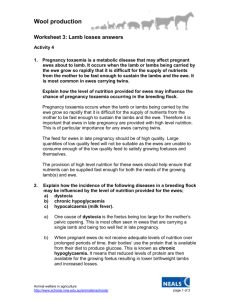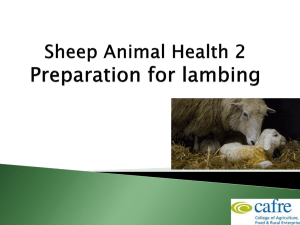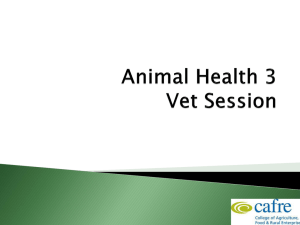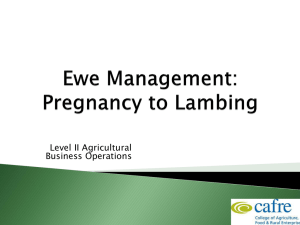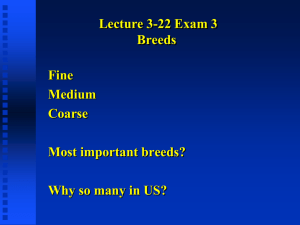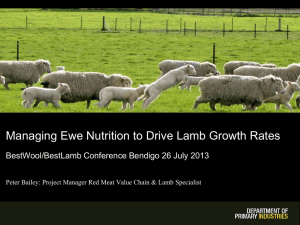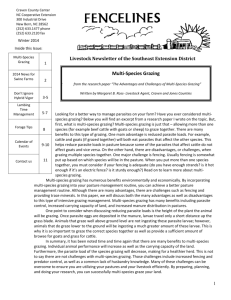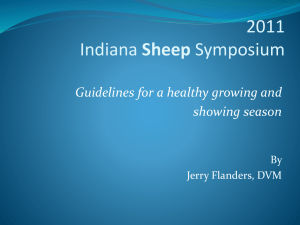CAFRE Development Service
advertisement
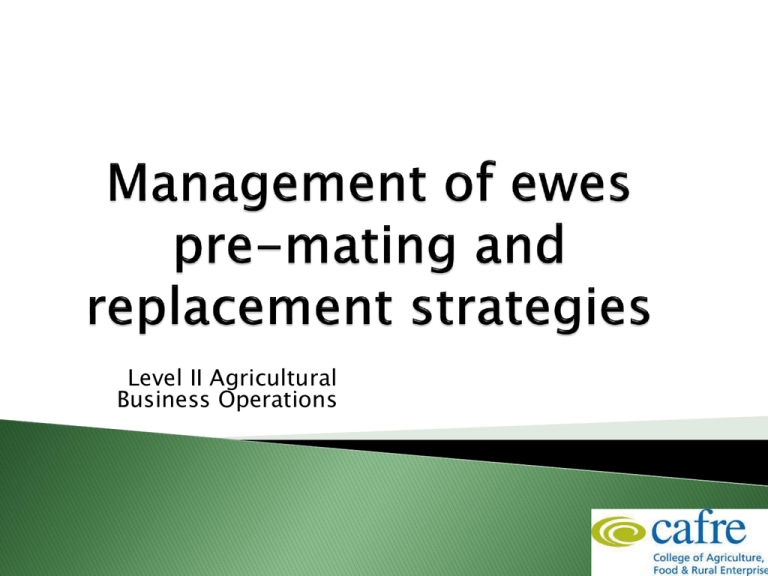
Level II Agricultural Business Operations Overview of the production cycle of a ewe Appropriate management of the flock pre mating to achieve optimum performance Identify the most suitable option for selecting replacements Unlike cattle sheep have a distinct breeding season linked to day length As day length decreases sheep begin to come on heat Different breeds will cycle at slightly different times Breeding season affects choice of breed Lowland breeds and crosses cycle – Aug – Feb Hill breeds – Oct – Jan Some breeds, e.g., Dorset Horn can breed almost any time of year (for early lambing systems, mate in July) When in season a ewe comes on heat every 16 – 17 days Each heat lasts for 24-36 hours Gestation period 147 days (21 weeks) July/Aug The number of eggs shed at each ovulation Affects number of lambs born to the ewe A number of factors affect the ovulation rate ◦ Breed – in general terms ewes of hill breeds have lower ovulation rates than those of low ground breeds ◦ Nutrition Age – ovulation rate is low in the ewe lamb, rises to peak at about 4 years of age, stays the same for a few years and then drops. Body condition – ewes in poor condition have lower ovulation rates Stage of breeding season – ovulation rate is low at the beginning and end of the breeding season and highest at the midpoint Starts at weaning Ensure ewes have enough time to recover between weaning and mating Assess ewe body condition Condition scoring is method of estimating the condition or 'nutritional well being' of a ewe It requires an assessment of the amount of muscle and fat covering the backbone and the short ribs of each sheep This gives a picture of the sheep’s store of energy Use body condition scoring to guide your feeding management pre-mating and throughout pregnancy. Wean lowland ewes July-mid August Hill ewes no later than end of September This give ewes time to gradually gain condition Ensure ewes are appropriately dried off May sort off culls at this stage for marketing ◦ Bad udders etc. Prolapsed Records / ear notch No lambs Poor mother Poor milker Hard to lamb Dead lambs Rejected lambs Reassess body condition ideally 8-6 weeks before mating date Feed ewes accordingly to achieve desired BCS Check udders/teeth/feet etc Treatments Cast/culls Sward height DM intake Kg per day 2.5 or below 5–7 1.3 – 1.4 3.0 – 3.5 4 0.8 – 0.9 4+ 3 0.7 Ewe body condition score Low Optimum High • Monitor condition regularly until rams go in and adjust feeding to avoid excessive loss or gain in condition Not needed for ewes BS >3.0 Very fat ewes = increased barrenness Very thin ewes = low lamb numbers Increase by 1 body score takes about 6 weeks on good grass at 7-9 cm ◦ (appox. 8-12kg for mature lowland ewe) If grass is short can offer additional feed Check feet, footbath, cull persistently lame sheep Crutch dirty/long tailed ewes Dose for liver fluke as per vet advice Vaccinations If dipping, do this 1 month before tupping Where possible carry out all management tasks at least 2 weeks prior to tupping Clostridial & Pasteurella (Hep P+) Two vaccines given 4-6 weeks apart Toxoplasa abortion Live vaccine –up to 1 month prior to tupping. Lasts 2-3 years (Toxovax) Enzootic abortion Live vaccine – up to 1 month prior to tupping. (Enzovax, Chlamydophila) • Assess mineral status of ewes • Blood sample 6-8 weeks before mating (Selenium, Cobalt, Iodine) • AFBI research found 50% hill ewes sampled had inadequate selenium (Se) status • Benefits of Se supplementation of ewes – Se supplementation 4-6 weeks before mating improves ewe fertility – Higher growth rates, heavier lambs at weaning – Ewe body weight and condition maintained more efficiently, higher overall lamb output • Methods of supplementation – Injectable, boluses, drenches and feed additives On average 10% of ewes in a flock fail to rear lambs Ewe and lamb deaths contribute to the biggest loss in productivity (37%) Older ewes are more prone to ewe deaths, abortion/stillbirths, lamb deaths Hence replacing/culling these ewes becomes necessary before A ewe should be replaced unproductive season Typically after 5 crops Important to record and identify problem ewes so they don’t get a reprieve ◦ Ear notch/tag Replacement rate ◦ Typically 20% for lowland flock ◦ Potentially 25 – 30% on a hill farm she has an Prolific Strong maternal ability Good milker (lamb growth) Produce quality lambs with good growth rate Hardy / disease resistance Reasonable size / conformation Minimum cost to feed and treat Easy lambing Durable Keep your own ewe lambs Purchase ewe lambs Purchase sucked hoggets Purchase dry hoggets Draft ewes Advantages Disease risks are lower Quality – greater control over management Disadvantages Management can be complex Potential to improve ewe type - maternal sires Good records Cheaper? Breeding policy must be planned Cheaper? Advantages Replacements can be bought as shearlings Disadvantages Higher risk of disease No control over the rearing phase No prior knowledge Autumn sales are fixed Hybrid vigour Less complex recording? Less time consuming Little time for introduction to flock Conception rates are lower Lamb mortality can be high due to There is a greater risk of mismothering Good feeding is essential to ◦ 90% or less ◦ average litter size of 1.0-1.2 ◦ Lambing difficulties, small lambs, lack of milk etc ◦ Sustain growth of the ewe lamb ◦ Enable the production of adequately sized lambs and sufficient milk. May be cheaper than gimmers/hoggets Extra crop of lambs (if lambed) ◦ Harder to lamb/manage ◦ Easier to manage following year if lambed Need to be 60-70% of mature weight going to the ram Can stunt growth Extended lambing season Two aspects of flock health must be considered when introducing replacements 1. If bought in – must not be allowed to bring diseases such as scab or enzootic abortion into the flock 2. They have to be protected against the main causes of losses, such as clostridial diseases, pneumonia and infectious abortion 1. Yard all sheep (rams and ewes) on arrival for 24- 2. Treat asap 48 hours Worm treatment Fluke treatment Vaccination – Clostridial diseases, sheep scab, Toxovax, Enzovax Foot care – Inspection and footbath 3. Quarantine – turn out to pasture previously grazed by own flock and keep isolated for 3 weeks Size, length, conformation Legs and feet Mouth and teeth Wool Reproductive organs Breed characteristics EBVs (Scan weight) Body score 3.5 – 4 (Feed meal 8 - 10 weeks prior to tupping) Handle testicles – Should be hard without bumps or lumps, check for epididymis Mouth – Check for broken mouth Temperature and wellbeing Feet Brisket sores Management of the mating period Management of the mating period 1. Select mating date so that lambing coincides with spring grass! http://www.tvsp.org/gestation.html 2. Restrict mating period to 35-42 days to reduce lambing period and minimise lamb weight variation 1 mature ram: 40 ewes (A fit, 2 shear, ram will cope with more as will certain breeds – e.g. Highlander/Primera) Ram pool, 3 rams – 150 -200 ewes Raddle/harness crayon colour should be changed regularly ◦ More frequent changes gives more control of feeding Excessive repeats (25-30%+) indicates a problem with ram fertility Vasectomise at least 8 weeks before they are needed Use one teaser for 100 -150 ewes Put teasers in for 17 days max Remove before fertile rams are introduced Alternatively: Run entire rams on opposite side of secure fence line for 14 days before introducing to ewes Maintain body score (3.5) Embryo floats about in uterus Don’t dramatically increase or decrease feeding Avoid unnecessary handling and stress Ewes served at the correct body score is the 1st step in achieving a high lambing percentage Carry out a ram MOT early and use rams at correct ratio Manage nutrition carefully after mating Remove culls and obtain replacements Use appropriate vaccines and drenches Nutrition of the pregnant ewe Getting the feeding right to reduce lamb and ewe mortality What to look for in a good ewe feed Simple rations Level of concentrate feeding required


